The island of Bali, Indonesia’s most popular tourist destination, is a vacationer’s dream. And while you could easily spend a month exploring the Island of the Gods, 10 days is a reasonable amount of time for your first visit. You’ll leave with a well-rounded view of the island’s best beaches and jungles, ancient temples, and top photo spots. Read on, for recommendations on the ideal 10 day Bali itinerary.
Jump to:
- Day 1: Arrive, Overnight in Nusa Dua or Sanur
- Day 2 — 4: Gili Islands
- Day 5 — 8: Ubud
- Day 9 — 10: Beaches
- Things to Know Before You Go
Day 1: Overnight in Nusa Dua or Sanur
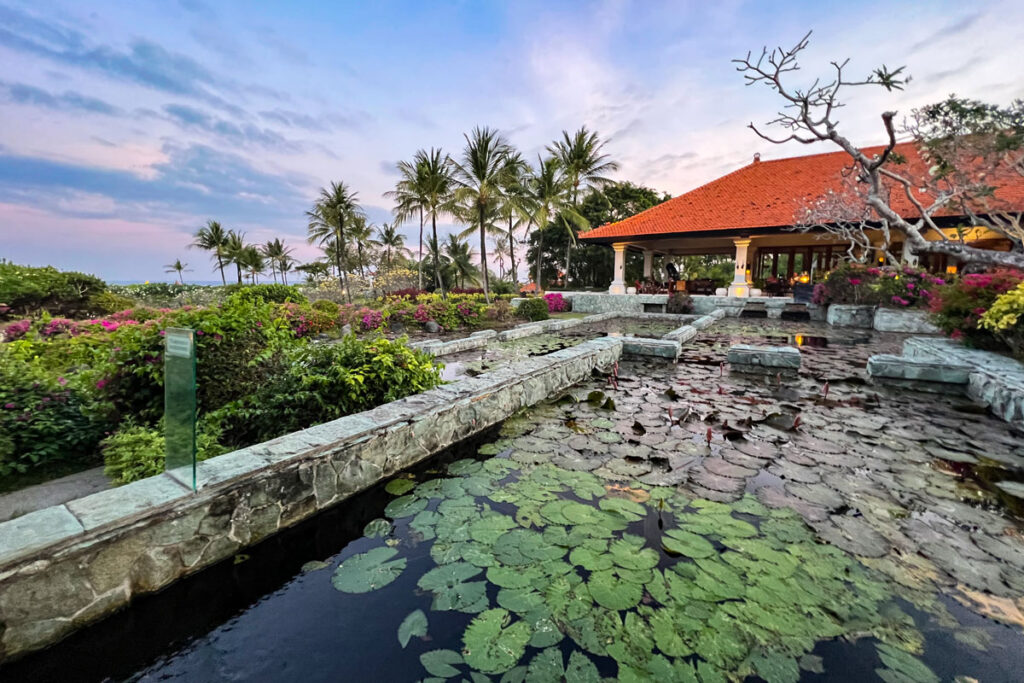
Most likely, your flight will arrive in the afternoon of the first day, not leaving much time on day #1.
We recommend an overnight in either Nusa Dua or Sanur. Each is close to the airport, with comfortable resort hotels that will allow you to unwind after a long flight.
While it may not be exotic Indonesia, there’s something to be said for riding out your jet lag poolside. You’ll have numerous amenities close by, and will wake up refreshed and ready to go tomorrow morning.
Day 2 — 4: Gili Islands
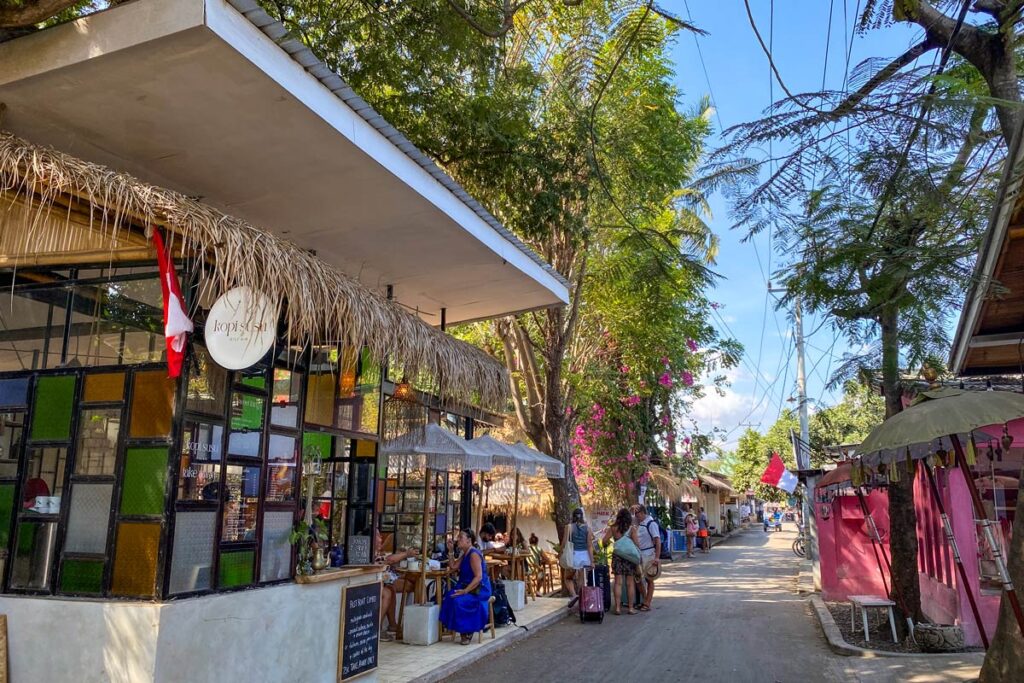
The Gili Islands, located in the Lombok Strait off the coast of Bali, have become a trendy destination in recent years, among those who feel Bali has become too “mainstream.”
In contrast to Hindu Bali, the Gilis are Muslim, and much of their appeal is the slower pace of island life. It’s a different perspective of Indonesia, that feels far removed from the congestion and tourist hordes of Bali.
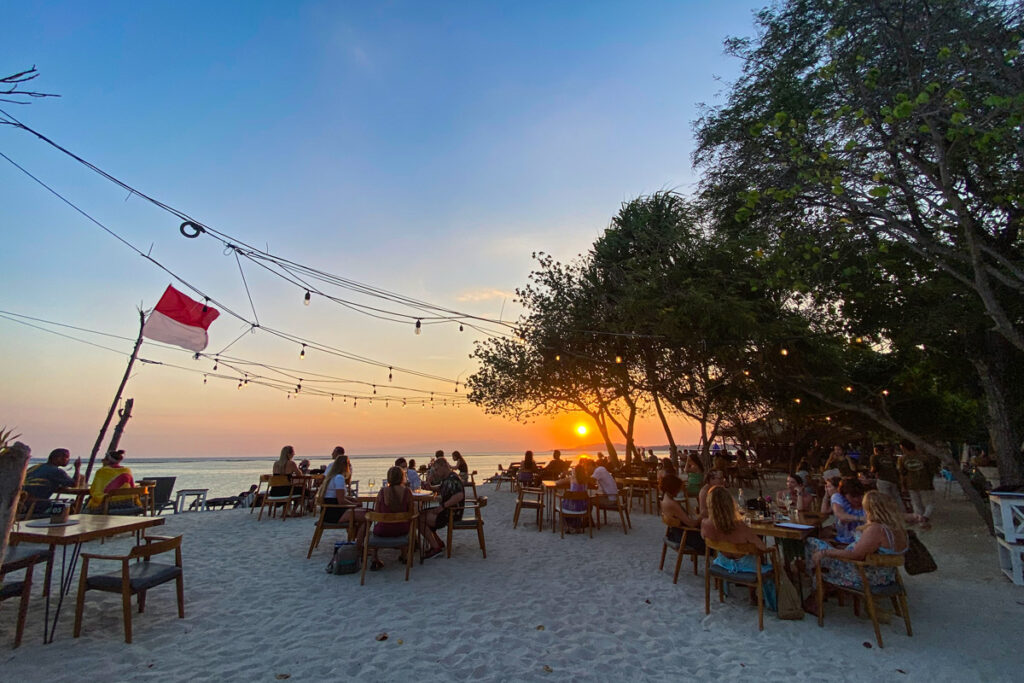
The Gilis are made up of three islands. Gili Trawangan (affectionally known as “Gili T”) is famous for its parties and nightlife. Conversely, Gili Meno sits quietly at the other end of the spectrum, best reserved for honeymooners and those desiring solitude. Lastly, Gili Air is the happy medium of the three, with varying stretches of chill beach bars and secluded shores.
Regardless of which island you choose to visit, three days is a good amount of time to comfortably experience the Gilis. You’ll find balmy white-sand beaches, vibrant tropical reefs perfect for snorkeling and scuba diving, and plenty of boho island vibes.
Ferries to the Gili Islands run every morning from the eastern shores of Bali. Ports include either Serangan (near Nusa Dua), Padang Bai (central coast), or Amed (northern coast).
You can read more about how to spend 3 days on Gili Air here.
Day 5 – 8: Ubud
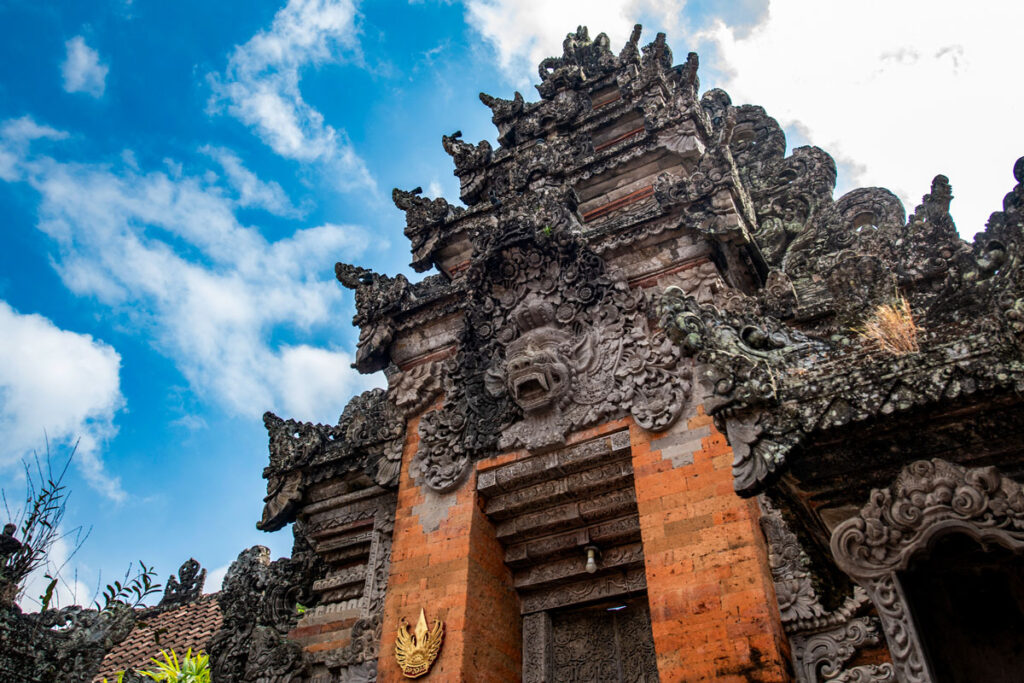
Ubud is the spiritual heart of Bali, and no trip to the island is complete without a visit. Here, you’ll find verdant jungle, ancient temples, hip restaurants, and an ethereal, mystic beauty that courses through it all.
With four days to spend in Ubud, we recommend planning your itinerary as follows.
Day 5: Ubud Palace, Saraswati Temple, Goa Gajah Elephant Cave
Once you arrive in Ubud, set off for the town center, where two of Ubud’s most recognizable landmarks, Ubud Palace and Saraswati Temple are merely a block apart.
Ubud Palace
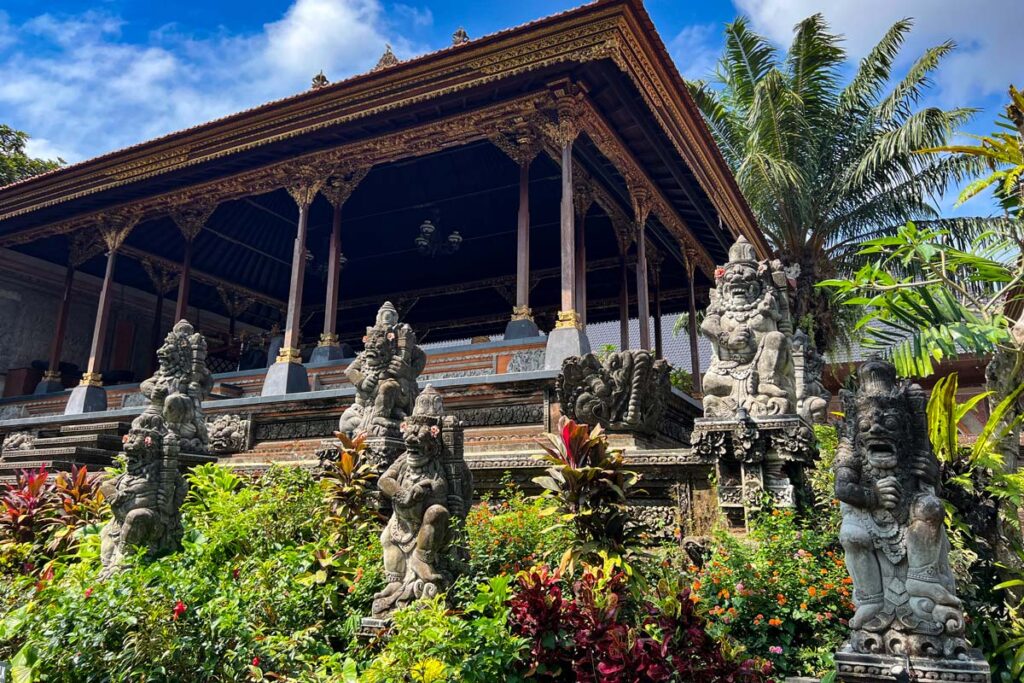
Ubud Palace was the 19th century home of the royal family, and remains a beautiful example of traditional Balinese architecture.
With an open air stage on the grounds, the palace frequently hosts Balinese dance performances, and you may be lucky enough to catch a show while you’re here. Directions.
Saraswati Temple
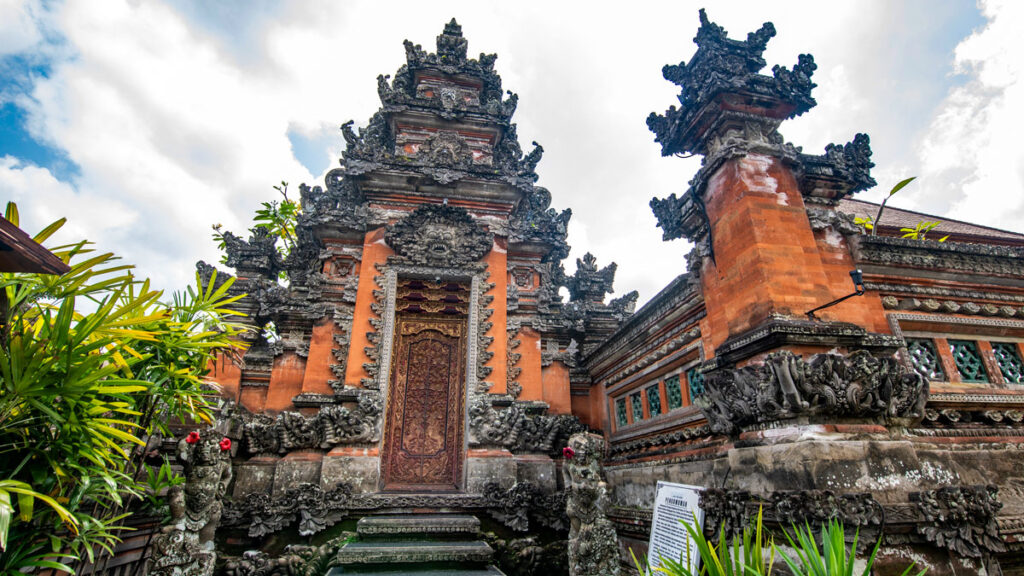
Also known as the Water Palace, Saraswati is a stunning Hindu temple famed for the expansive lotus pond that fronts the complex.
While visitors won’t be able to enter the inner sanctum, strolling the outer grounds is still a top highlight of things to do while in Ubud. Directions.
Goa Gajah Elephant Cave
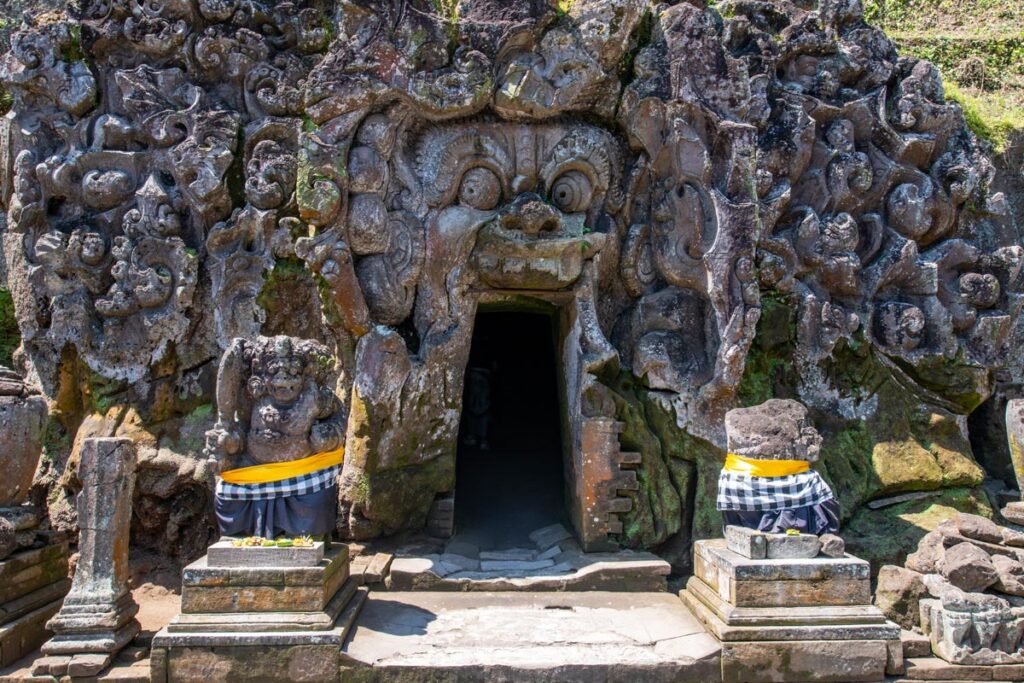
To complete the trifecta of Ubud’s most famous temples, end the day at Goa Gajah Elephant Cave, which is just a 10-minute drive from the town center.
Goa Gajah dates back to the 9th century, and was an important stop for ancient pilgrims. The entire complex includes lush gardens and fountains, but the main shrine consists of a small cave, with a grinning face (presumably the Hindu god Ganesh) intricately carved into the entryway.
Stepping inside, you’ll follow wafting incense to an inner sanctuary that hasn’t changed for 1,000 years. Goa Gajah was only rediscovered by archeologists in the 1920s, and it feels straight out of Indiana Jones. Directions.
Day 6: Tegallalang Rice Terrace, Tirta Empul, Gunung Kawi
Today is a good day to venture just outside of Ubud, where some of the island’s most popular photo spots all sit within a 30-minute drive.
We recommend getting an early start, as the light is best at Tegallalang in the early morning, and you’ll want to beat the crowds to Tirta Empul.
Tegallalang Rice Terrace
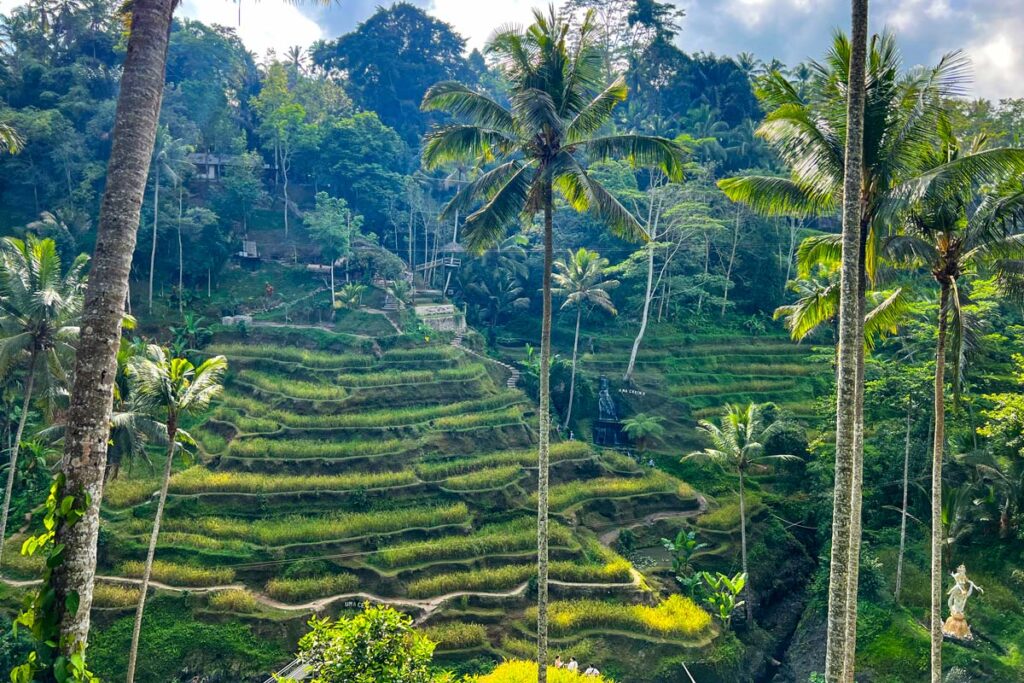
Begin at Tegallalang Rice Terrace, which is one of Bali’s most widely-recognized photos. If you’ve ever admired the glossy marketing images of steeply terraced rice paddies, framed by lush vegetation and palms, it’s inevitably Tegallalang.
Tegallalang is best experienced in the soft light of early morning (or evening).
Know before you go: What once used to be expansive, meandering trails have recently been closed off by enterprising locals, who recognize an income opportunity when they see one.
Now, the many terraces are fenced off from one another, with each requiring a paid ticket for entry. You can still walk a decent distance along “your” section, but it’s not the holistic experience it once was.
While you can choose from multiple entry points, we personally did Uma Ceking, which is considered one of the primary stretches of Tegallalang.
Tirta Empul Temple

If you’re going to visit only one temple in Bali, then make it Tirta Empul.
This ancient shrine, built in 962 A.D. to honor the Hindu god Vishnu, is one of the holiest places on the island. Pilgrims have journeyed here for over a thousand years to bathe in the sacred waters, which flow from local mountain springs.
Tirta Empul is best in early morning, before the heat of the day and the worst of the crowds arrive. Plan to spend an hour or more here, as the entire complex is worth exploring, beyond just the purification pools.
Proper attire (to enter the pools) is included with your entry ticket. Please just remember that this is an active house of worship, and be respectful during your time here. Directions.
Gunung Kawi Temple
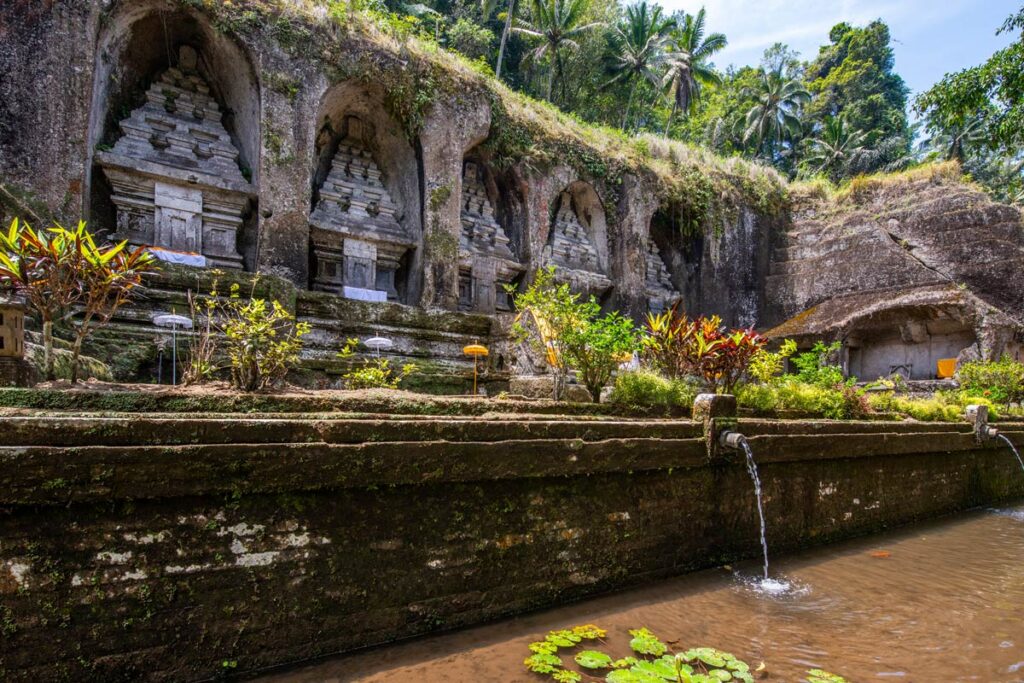
Just 5 minutes down the road from Tirta Empul, the 11th century Gunung Kawi is another ancient marvel.
Known as the Valley of the Balinese Kings, it includes 10 shrines carved into a cliff face, as well as with tranquil rice terraces and jungle terrain.
To get here, you’ll park at the top of the hill and then walk approximately 10 minutes down into the ravine where the temple is located. The entire visit should take just under an hour.
Day 7: Wellness Day, Campuhan Ridge Walk
Ubud is renowned for its wellness culture, and we highly recommend reserving a “down day” to fully soak up its restorative properties. Enjoy lounging poolside, or perhaps indulge in either a yoga class or restorative massage.
Additionally, Indonesia is one of the world’s leading coffee exporters, and you can sample many craft roasts at Ubud’s local coffee shops.
Yoga
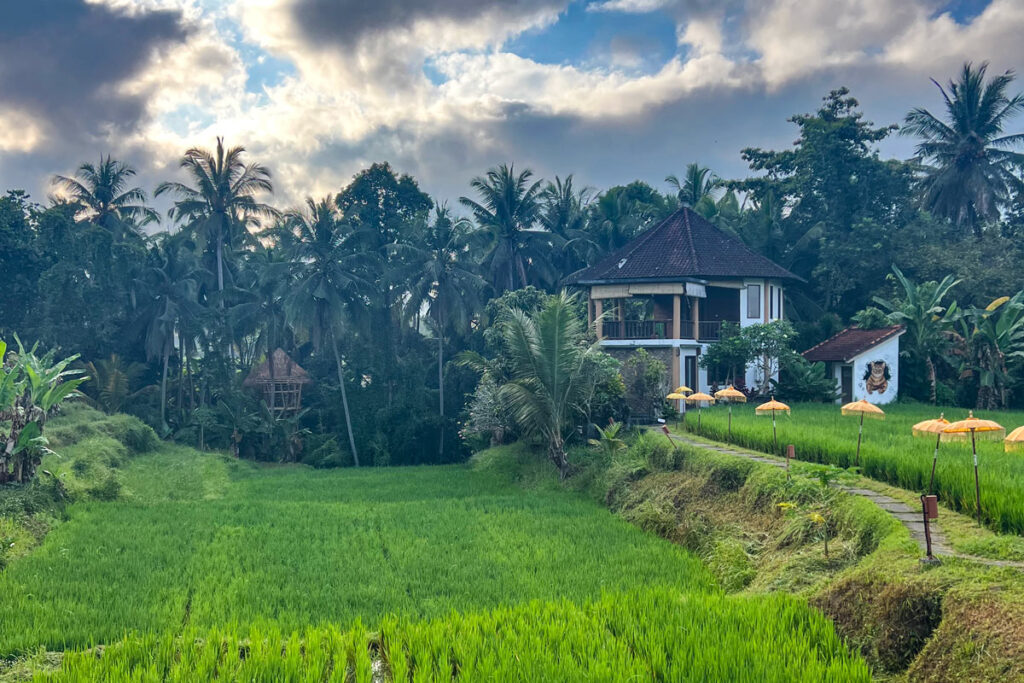
Ubud has long been a mecca for yoga practitioners, and joining a yoga class almost feels like a cultural necessity to experience while here. There are more studios in Ubud than you could ever hope to visit in one trip, with classes for every style and ability level.
Some of the more famous studios include Radiantly Alive and The Yoga Barn.
Personally, we are partial to Ubud Yoga House, which came recommended to us by a few different professional instructors in town. Situated along a serene rice paddy, on the edge of thick jungle, the morning vinyasa class is the perfect way to start your day.
Massage

Day spas abound in Ubud, where you can choose from a host of treatments that are all relatively cheap for those used to Western prices.
Some of the more highly rated spots include either Ubud Traditional Spa, Jaens Spa Center, or Karsa.
Or, for a cheaper hidden gem, we also found Synergy Spa, where a modest storefront belied a quality Balinese massage. Each treatment comes with aromatherapy oils of your choice, as well as a refreshing tea afterwards.
Sample Indonesian Coffee

If you’re the type that can’t sit still, you can still enjoy a more languid day by venturing to one of Ubud’s hip coffee shops to sample local brews. Indonesia is one of the top coffee exporters in the world, and knowledgeable baristas can help suggest a series of regional specialties to suit your taste.
Ubud Coffee Roastery is one of our favorites, specializing in 100% Indonesian Arabica beans. They offer single-origin brews from across Indonesia, thus allowing you to sample the subtle differences of five or six different sub-regions.
Seniman Coffee is another local legend for speciality brews, with a roastery just across the street from the shop.
And if you still aren’t caffeinated enough, make your way to Anomali Coffee. They take their mission to promote speciality Indonesian beans seriously, even offering a barista course through the Indonesian Coffee Academy.
Campuhan Ridge Walk
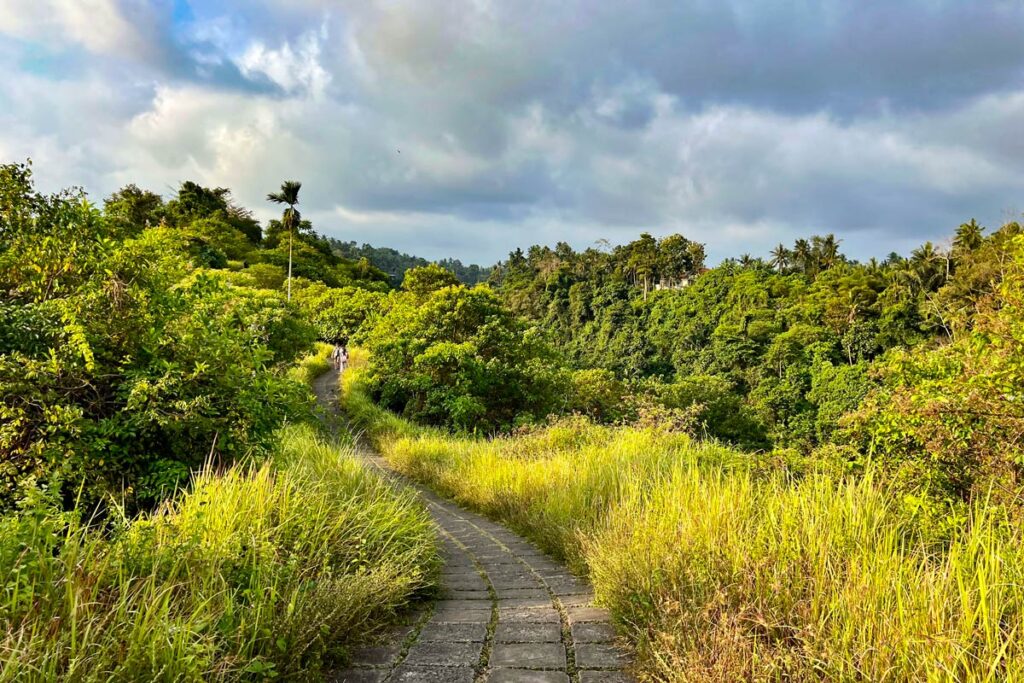
Complete your leisurely day in Ubud with an evening stroll along the Campuhan Ridge Walk. This popular footpath traverses one of the hilltops running north out of town, and is best in the soft light of morning or evening.
The full trail is 4.5 kilometers (approximately 3 miles) roundtrip, but you can complete as much or as little as you wish.
Along the way, you’ll gently wind along the ridge line, with views of peaceful rice terraces and resorts tucked into the hillsides. Directions.
Day 8: Day Trip to Northern Bali
For a more authentic look at “real” Bali, take a day trip to the northern side of the island, where local village life lives alongside untamed nature.
Transit Note: while destinations don’t appear far on a map, roads are slow and the drive takes about 2 hours each way from Ubud. The easiest transportation is via private driver (see Private Cars section below). For about $40 USD a day, your driver will pick you up and drive you wherever you want to go, before returning you to your hotel that evening.
Jatiluwih Rice Terraces
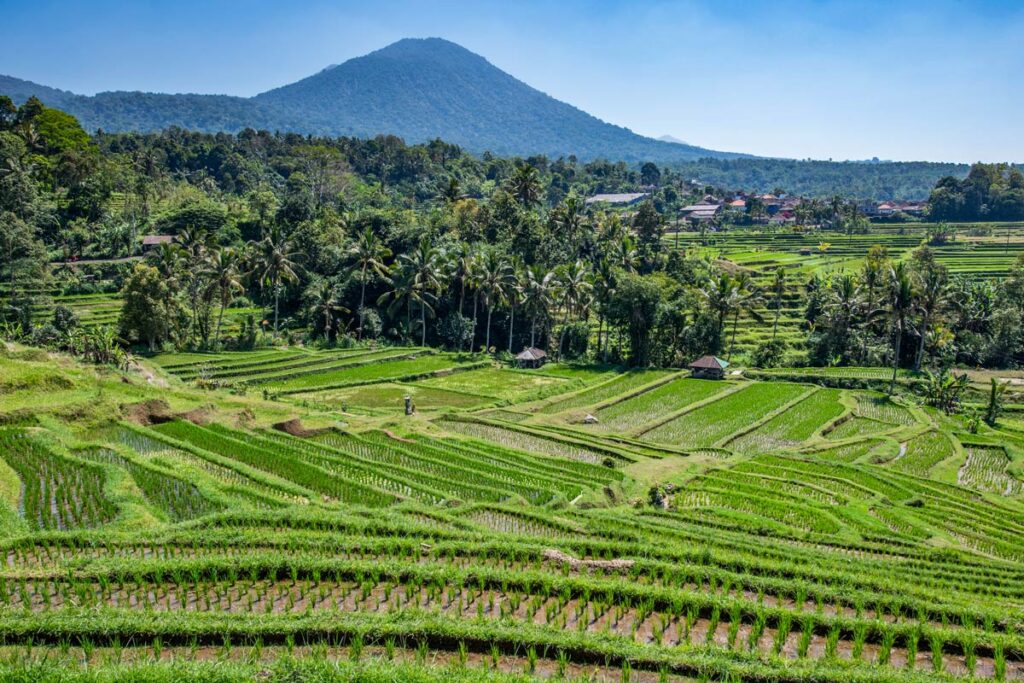
These emerald rice terraces sprawl over many hectares, and are frequently touted as an alternative to Tegallalang. Neither is better than the other, they’re just different.
Jatiluwih is much more expansive than Tegallalang, and you can easily pass an hour traversing the multiple kilometers of trails.
Jatiluwih is open farmland, and while it lacks the lush jungle of Tegallalang, the resulting vistas offer crisp views of Mount Abung, Bali’s tallest volcano, in the distance. Directions.
Sekumpul Waterfall
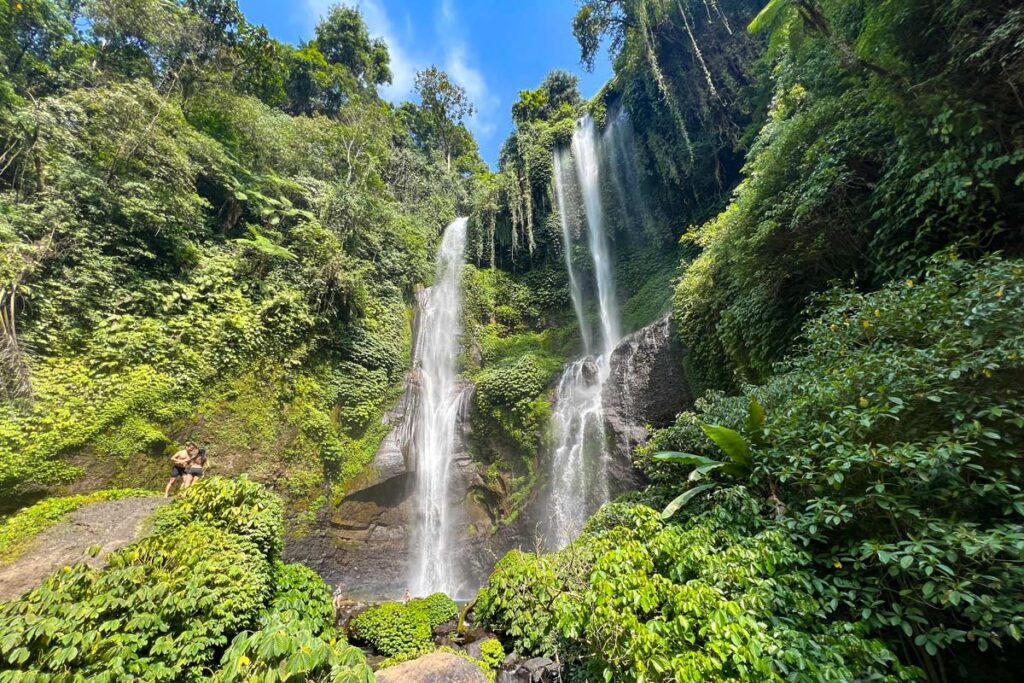
From Jatiluwih, continue on to Sekumpul Waterfall, which is the tallest on the island. A few separate streams converge at the crest, before plummeting 80 meters (260 feet) to the pool below.
At the parking lot, you’ll purchase your ticket (tickets are mandatory, to access the waterfalls) and be assigned a local guide. From here, it’s a 5-10 minute ride on the back of your guide’s motorbike to the trailhead.
The total hike is about 15 minutes each way, including a set of 350 stairs to the ravine below.

Your guide will take you to both Sekumpul and Fiji Waterfall, another powerful cascade that’s another 5-minute hike beyond Sekumpul.
Don’t forget your bathing suit — after a hike through humid jungle, a swim in the pools at the base of the waterfall is too inviting to pass up!
We recommend wearing comfortable sneakers or water shoes with grip, which help when traversing the dirt footpaths and scrambling over rocks to reach the falls. Directions.
Sangeh Monkey Forest
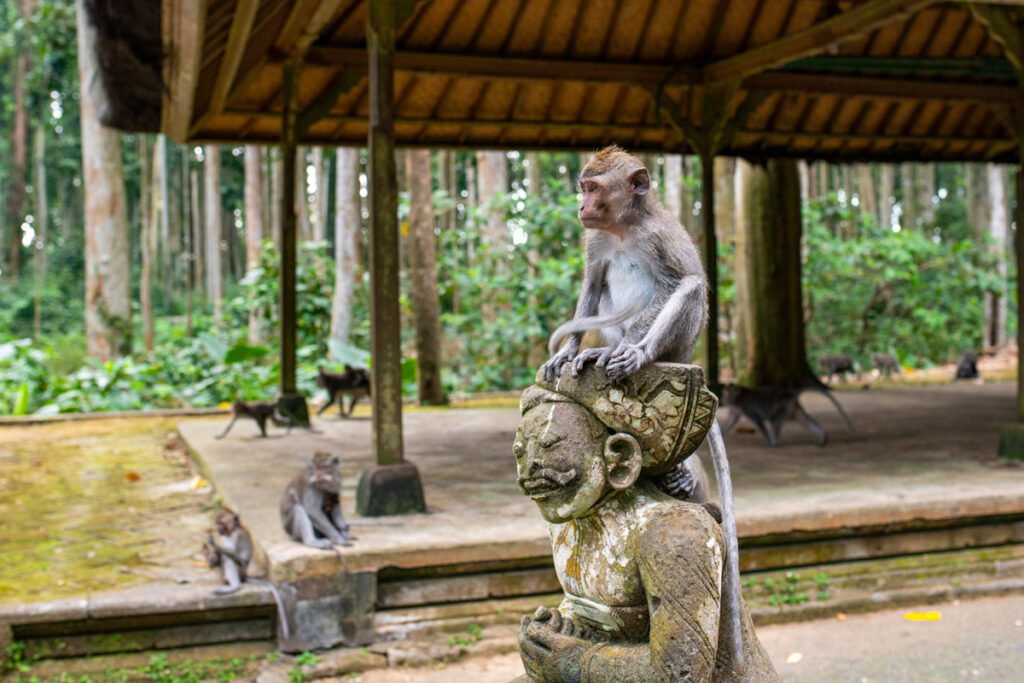
Located just 25 minutes outside of Ubud on your return, Sangeh is a refreshing alternative to the more famous Ubud Monkey Forest. You’ll still get the full simian experience, albeit in a more natural setting and with less aggressive monkeys.
The protected forest consists of 14 hectares, along with a 17th century temple. You’ll see hundreds of local macaques, who roam free on the grounds.
Local guides will lead you on a personal tour through the grounds, and help you capture plenty of photos with the monkeys. Just remember to tip your guide on the way out. Directions.
Safety Tip #1: be careful of your belongings. The macaques love snatching anything they can grab, and are smart enough to steal phones and sunglasses to barter for snacks. Don’t bring anything with you that you don’t absolutely need. Especially don’t carry food!
Safety Tip #2: don’t make eye contact with the monkeys. They see this as a sign of aggression, and will not hesitate to react. One member of our group momentarily forgot this cardinal rule and was immediately punched in the face.
Day 9 — 10: Beaches
For your last few days on Bali, head back to the coast for one final dose of vitamin D. Here we leave the destination flexible, depending on what type of activity you’re looking for.
Personally, we recommend either Uluwatu, Canggu, or Seminyak, for the reasons detailed below. No matter which beach you choose, you’ll also be reasonably close to the airport for an easy departure at the close of your trip.
Best for Pretty Beaches, Intermediate to Advanced Surfing: Uluwatu
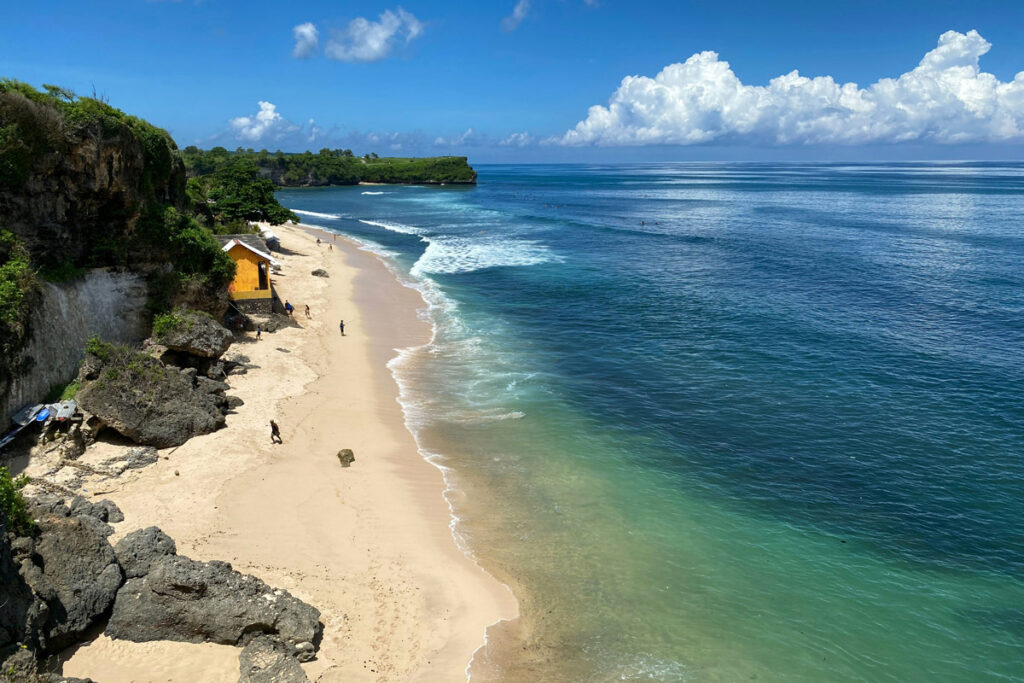
If you’re solely looking to lounge on beautiful sunny beaches, set off for Uluwatu, which sits on Bali’s southern Bukit Peninsula.
Some classic spots here include Thomas Beach, Padang Padang, and Dreamland. Uluwatu is also a surfer’s paradise for those with intermediate to advanced skills.
Best for Beginner to Intermediate Surfing: Canggu

For those who want to spend these last Bali days surfing, but are more of a beginner to intermediate level, Canggu is a good destination.
Waves here are gentle, and you can rent boards for cheap at Batu Bolong Beach. There are also plenty of surf schools, with instructors happy to teach beginners or improve intermediate surfers’ technique.
Best for Beach Clubs and Parties: Seminyak and Kuta
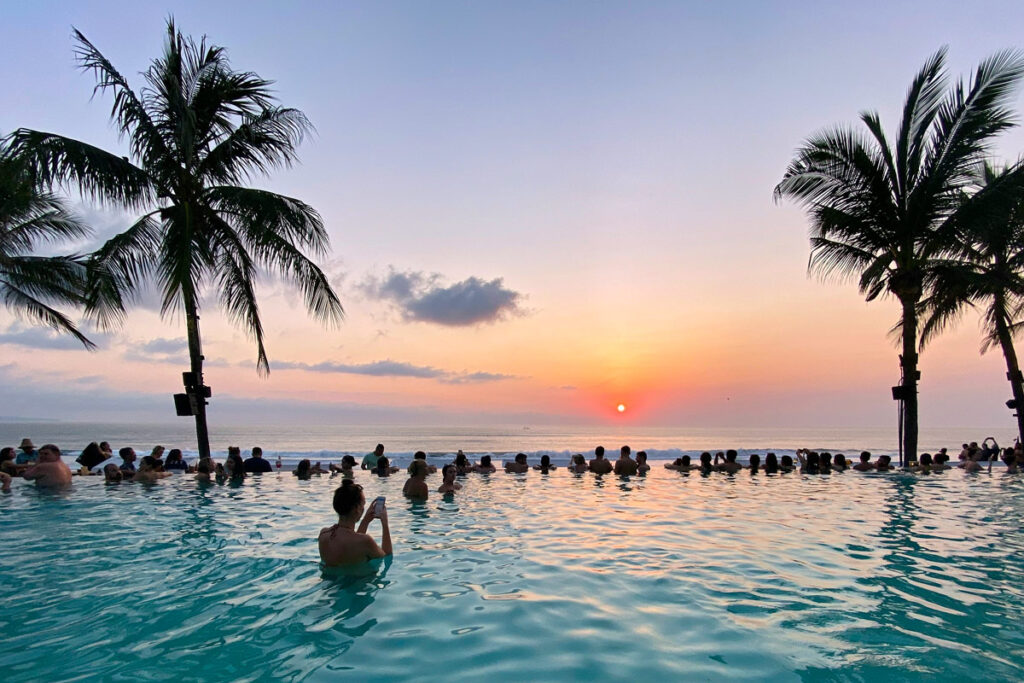
As a third option, revelers in search of a good time can head to Seminyak and Kuta. Located just south of Canggu, this stretch of coastline is the undisputed leader for bacchanalia.
Between beach-side day clubs and rousing nightlife, you’ll always find a party here.
Seminyak and Kuta also have the same gentle waves that break at Canggu, making them another good option for beginner and intermediate surfers.
Things to Know Before You Go
Entry Fees
Indonesian Visa Requirements (cost: 500,000 IDR)
International travelers must obtain a visa in order to enter Indonesia. The associated fee is 500,000 IDR (approximately $35 USD) and can be obtained online.
Tourism Fee (cost: 150,000 IDR)
Additionally, in 2024 the Indonesian government also introduced a new tourism fee that all international visitors are required to pay upon arrival. The 150,000 IDR (approximately $10 USD) fee is separate from the visa fee listed above, and is intended for environmental conservation and cultural preservation.
Getting Around Bali
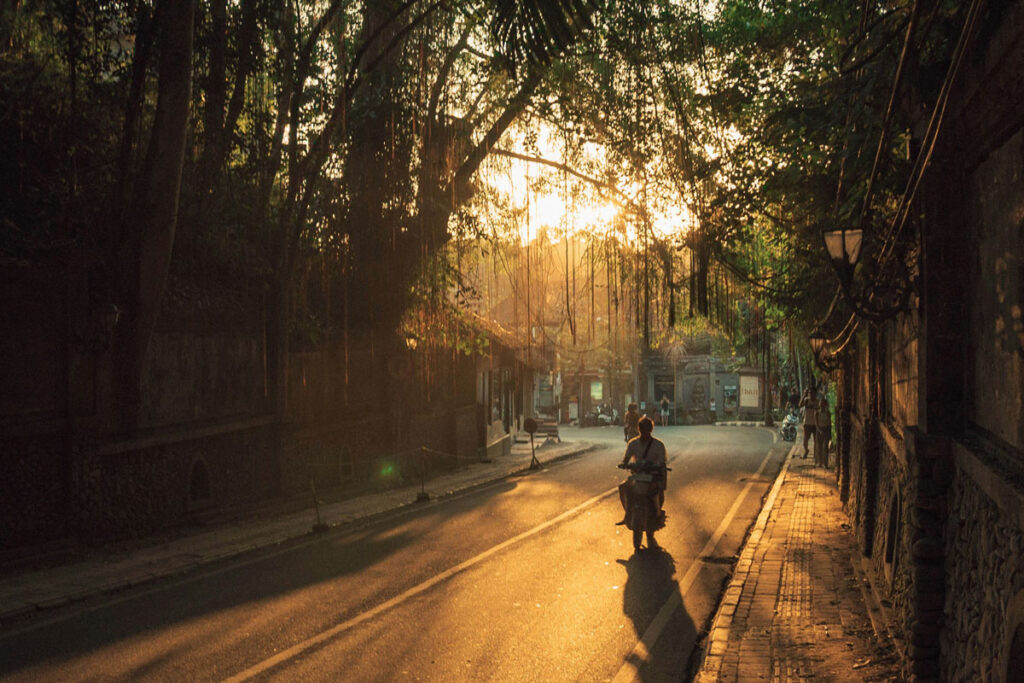
Public transit is nonexistent in Bali, but both private drivers and the Grab app are an economical way to get around, without costing too much money.
Private Car
Many Balinese work as private drivers, offering affordable rides for anywhere you want to go on the island. The drivers do not have websites, instead operating off SMS and word of mouth.
You can book a driver for everything from short drives to a full day. For example, a 10-hour day will cost around $40 USD.
Every tourist seems to have a “guy”, recommended to them by a friend who has visited Bali previously. For what it’s worth, we used Agus, who was great (phone: +62 813-3764-8755). Another wonderful driver is Reny (+62 819-9785-3082).
Grab (the Uber of Southeast Asia)
Grab is extremely prevalent around Bali, and offers a low-cost and convenient way to get around.
You can download the Grab app in either the Apple or Google Play store. Drivers typically arrive within minutes, and rates are insanely cheap. For example, a 20-minute drive will typically cost around $1 USD.
What to Wear to Temples and Sacred Sites
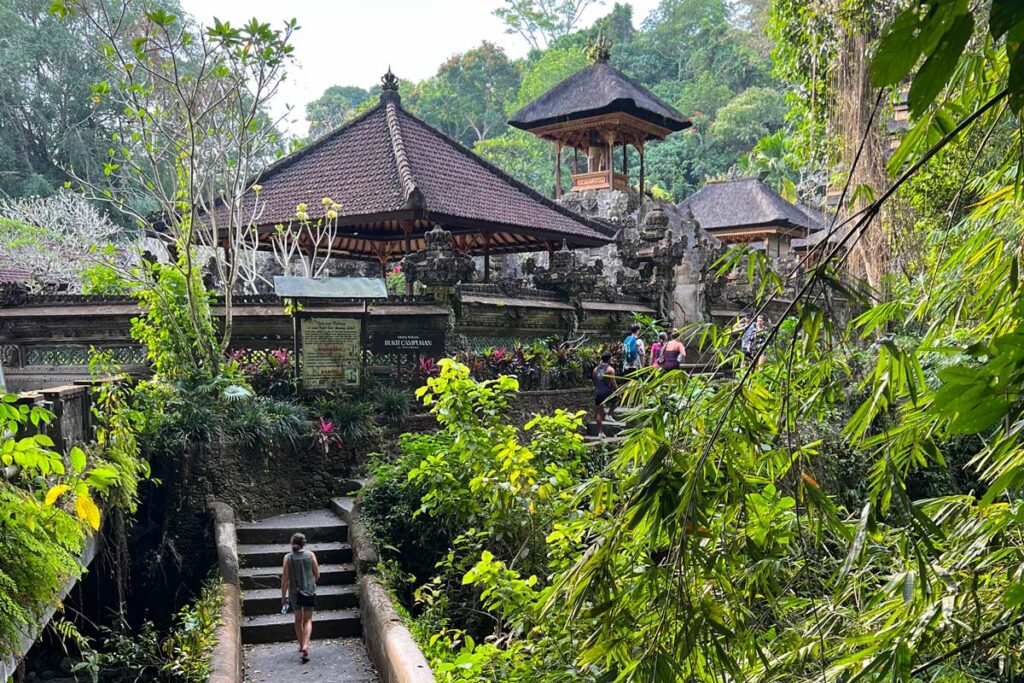
The island of Bali is Hindu, and with that comes a robust cultural and religious history. Thousand-year-old temples are dotted throughout the landscape, and have become popular tourist destinations.
When visiting temples, be sure to dress modestly and behave reverently, as you would in any other house of worship.
Both men and women should take care to wear a shirt that covers their shoulders and upper arms, while also covering their legs down to the ankles. Both of these are easily accomplished by a simple sarong wrap. You can wait until arriving in Bali to purchase a sarong, where they are very cheap and plentiful.
Most temples also offer cover-ups included with an entry ticket, but it doesn’t hurt to have your own sarong on hand.
Bali Belly: A Quick Note on Eating and Drinking

You’ve probably heard of the infamous “Bali Belly,” which affects Western digestive systems unused to the local bacteria. Bali Belly is contracted through eating contaminated foods or drinking unfiltered water (the more medical term is “traveler’s diarrhea”).
While it’s wise to take precautions, with simple common sense it’s easy to avoid a bout with the Belly:
- Only drink bottled water.
- Wash your teeth with bottled water; never use the faucet.
- Avoid ice cubes, which could be frozen from untreated water.
- Practice caution when consuming fresh fruits and vegetables, which could have been washed with untreated water. For example, we’ll eat fresh produce that’s served at a restaurant catering to Western tourists, but skip it at the local warung.
Thankfully, the large numbers of tourists visiting the island have ensured that greater efforts are taken to minimize the risk of Bali Belly. You’re much less likely to contract a digestive bug here than you are in other, less developed regions of Indonesia.
For a deeper dive into Bali, check out our guides to the best restaurants in Ubud, where to eat in Canggu, and more.
